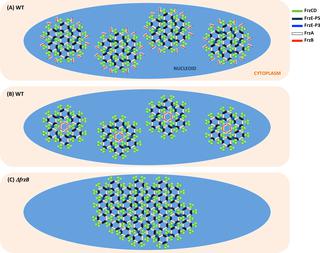当前位置:
X-MOL 学术
›
PLOS Genet.
›
论文详情
Our official English website, www.x-mol.net, welcomes your
feedback! (Note: you will need to create a separate account there.)
A divergent CheW confers plasticity to nucleoid-associated chemosensory arrays.
PLOS Genetics ( IF 4.0 ) Pub Date : 2019-12-20 , DOI: 10.1371/journal.pgen.1008533 Annick Guiseppi 1 , Juan Jesus Vicente 2 , Julien Herrou 1 , Deborah Byrne 3 , Aurelie Barneoud 1 , Audrey Moine 1 , Leon Espinosa 1 , Marie-Jeanne Basse 4 , Virginie Molle 5 , Tâm Mignot 1 , Philippe Roche 4 , Emilia M F Mauriello 1
PLOS Genetics ( IF 4.0 ) Pub Date : 2019-12-20 , DOI: 10.1371/journal.pgen.1008533 Annick Guiseppi 1 , Juan Jesus Vicente 2 , Julien Herrou 1 , Deborah Byrne 3 , Aurelie Barneoud 1 , Audrey Moine 1 , Leon Espinosa 1 , Marie-Jeanne Basse 4 , Virginie Molle 5 , Tâm Mignot 1 , Philippe Roche 4 , Emilia M F Mauriello 1
Affiliation

|
Chemosensory systems are highly organized signaling pathways that allow bacteria to adapt to environmental changes. The Frz chemosensory system from M. xanthus possesses two CheW-like proteins, FrzA (the core CheW) and FrzB. We found that FrzB does not interact with FrzE (the cognate CheA) as it lacks the amino acid region responsible for this interaction. FrzB, instead, acts upstream of FrzCD in the regulation of M. xanthus chemotaxis behaviors and activates the Frz pathway by allowing the formation and distribution of multiple chemosensory clusters on the nucleoid. These results, together, show that the lack of the CheA-interacting region in FrzB confers new functions to this small protein.
中文翻译:

发散的 CheW 赋予核相关化学感应阵列可塑性。
化学感应系统是高度组织化的信号通路,使细菌能够适应环境变化。来自 M. xanthus 的 Frz 化学感应系统拥有两种 CheW 样蛋白:FrzA(核心 CheW)和 FrzB。我们发现 FrzB 不与 FrzE(同源 CheA)相互作用,因为它缺乏负责这种相互作用的氨基酸区域。相反,FrzB 在调节 M. xanthus 趋化行为中作用于 FrzCD 的上游,并通过允许在核上形成和分布多个化学感应簇来激活 Frz 途径。这些结果共同表明,FrzB 中缺乏 CheA 相互作用区域赋予了这种小蛋白质新的功能。
更新日期:2019-12-21
中文翻译:

发散的 CheW 赋予核相关化学感应阵列可塑性。
化学感应系统是高度组织化的信号通路,使细菌能够适应环境变化。来自 M. xanthus 的 Frz 化学感应系统拥有两种 CheW 样蛋白:FrzA(核心 CheW)和 FrzB。我们发现 FrzB 不与 FrzE(同源 CheA)相互作用,因为它缺乏负责这种相互作用的氨基酸区域。相反,FrzB 在调节 M. xanthus 趋化行为中作用于 FrzCD 的上游,并通过允许在核上形成和分布多个化学感应簇来激活 Frz 途径。这些结果共同表明,FrzB 中缺乏 CheA 相互作用区域赋予了这种小蛋白质新的功能。











































 京公网安备 11010802027423号
京公网安备 11010802027423号